Abstract
The evaluation of angiogenesis inhibitors requires the analysis of the precise structure and function of tumor vessels. The anti-angiogenic agents lenvatinib and sorafenib are multi-target tyrosine kinase inhibitors that have been approved for the treatment of hepatocellular carcinoma (HCC). However, the different effects on tumor vasculature between lenvatinib and sorafenib are not well understood. In this study, we analyzed the effects of both drugs on vascular structure and function, including vascular normalization, and investigated whether the normalization had a positive effect on a combination therapy with the drugs and radiation using micro X-ray computed tomography with gold nanoparticles as a contrast agent, as well as immunohistochemical analysis and interstitial fluid pressure (IFP) measurement. In mice subcutaneously transplanted with mouse HCC cells, treatment with lenvatinib or sorafenib for 14 days inhibited tumor growth and reduced the tumor vessel volume density. However, analysis of integrated data on vessel density, rates of pericyte-covering and perfused vessels, tumor hypoxia, and IFP measured 4 days after drug treatment showed that treatment with 3 mg/kg of lenvatinib significantly reduced the microvessel density and normalized tumor vessels compared to treatment with 50 mg/kg of sorafenib. These results showed that lenvatinib induced vascular normalization and improved the intratumoral microenvironment in HCC tumors earlier and more effectively than sorafenib. Moreover, such changes increased the radiosensitivity of tumors and enhanced the effect of lenvatinib and radiation combination therapy, suggesting that this combination therapy is a powerful potential application against HCC.





Similar content being viewed by others
Data availability
All data and materials are available in this study.
References
Folkman J. Tumor angiogenesis: therapeutic implications. N Engl J Med. 1971;285(21):1182–6. https://doi.org/10.1056/nejm197111182852108.
Hanahan D, Weinberg RA. Hallmarks of cancer: the next generation. Cell. 2011;144(5):646–74. https://doi.org/10.1016/j.cell.2011.02.013.
Carmeliet P, Jain RK. Angiogenesis in cancer and other diseases. Nature. 2000;407(6801):249–57. https://doi.org/10.1038/35025220.
Bergers G, Benjamin LE. Tumorigenesis and the angiogenic switch. Nat Rev Cancer. 2003;3(6):401–10. https://doi.org/10.1038/nrc1093.
Jain RK. Molecular regulation of vessel maturation. Nat Med. 2003;9(6):685–93. https://doi.org/10.1038/nm0603-685.
Carmeliet P, Jain RK. Molecular mechanisms and clinical applications of angiogenesis. Nature. 2011;473(7347):298–307. https://doi.org/10.1038/nature10144.
Folkman J. Anti-angiogenesis: new concept for therapy of solid tumors. Ann Surg. 1972;175(3):409–16. https://doi.org/10.1097/00000658-197203000-00014.
Dewhirst MW, Cao Y, Moeller B. Cycling hypoxia and free radicals regulate angiogenesis and radiotherapy response. Nat Rev Cancer. 2008;8(6):425–37. https://doi.org/10.1038/nrc2397.
Wilson WR, Hay MP. Targeting hypoxia in cancer therapy. Nat Rev Cancer. 2011;11(6):393–410. https://doi.org/10.1038/nrc3064.
Jain RK. Normalization of tumor vasculature: an emerging concept in antiangiogenic therapy. Science. 2005;307(5706):58–62. https://doi.org/10.1126/science.1104819.
Shen G, Li Y, Du T, Shi G, Dai L, Chen X, et al. SKLB1002, a novel inhibitor of VEGF receptor 2 signaling, induces vascular normalization to improve systemically administered chemotherapy efficacy. Neoplasma. 2012;59(5):486–93. https://doi.org/10.4149/neo_2012_062.
Martin JD, Seano G, Jain RK. Normalizing function of tumor vessels: progress, opportunities, and challenges. Annu Rev Physiol. 2019;81:505–34. https://doi.org/10.1146/annurev-physiol-020518-114700.
Shigeta K, Datta M, Hato T, Kitahara S, Chen IX, Matsui A, et al. Dual programmed death receptor-1 and vascular endothelial growth factor receptor-2 blockade promotes vascular normalization and enhances antitumor immune responses in hepatocellular carcinoma. Hepatology. 2020;71(4):1247–61. https://doi.org/10.1002/hep.30889.
Finn RS, Qin S, Ikeda M, Galle PR, Ducreux M, Kim TY, et al. Atezolizumab plus bevacizumab in unresectable hepatocellular carcinoma. N Engl J Med. 2020;382(20):1894–905. https://doi.org/10.1056/NEJMoa1915745.
Bray F, Ferlay J, Soerjomataram I, Siegel RL, Torre LA, Jemal A. Global cancer statistics 2018: GLOBOCAN estimates of incidence and mortality worldwide for 36 cancers in 185 countries. CA Cancer J Clin. 2018;68(6):394–424. https://doi.org/10.3322/caac.21492.
Bruix J, Reig M, Sherman M. Evidence-based diagnosis, staging, and treatment of patients with hepatocellular carcinoma. Gastroenterology. 2016;150(4):835–53. https://doi.org/10.1053/j.gastro.2015.12.041.
Lau WY, Leung TW, Lai BS, Liew CT, Ho SK, Yu SC, et al. Preoperative systemic chemoimmunotherapy and sequential resection for unresectable hepatocellular carcinoma. Ann Surg. 2001;233(2):236–41. https://doi.org/10.1097/00000658-200102000-00013.
EASL Clinical Practice Guidelines. Management of hepatocellular carcinoma. J Hepatol. 2018;69(1):182–236. https://doi.org/10.1016/j.jhep.2018.03.019.
Llovet JM, Ricci S, Mazzaferro V, Hilgard P, Gane E, Blanc JF, et al. Sorafenib in advanced hepatocellular carcinoma. N Engl J Med. 2008;359(4):378–90. https://doi.org/10.1056/NEJMoa0708857.
Cheng AL, Kang YK, Chen Z, Tsao CJ, Qin S, Kim JS, et al. Efficacy and safety of sorafenib in patients in the Asia-Pacific region with advanced hepatocellular carcinoma: a phase III randomised, double-blind, placebo-controlled trial. Lancet Oncol. 2009;10(1):25–34. https://doi.org/10.1016/s1470-2045(08)70285-7.
Kudo M, Finn RS, Qin S, Han KH, Ikeda K, Piscaglia F, et al. Lenvatinib versus sorafenib in first-line treatment of patients with unresectable hepatocellular carcinoma: a randomised phase 3 non-inferiority trial. Lancet. 2018;391(10126):1163–73. https://doi.org/10.1016/s0140-6736(18)30207-1.
Bruix J, Qin S, Merle P, Granito A, Huang YH, Bodoky G, et al. Regorafenib for patients with hepatocellular carcinoma who progressed on sorafenib treatment (RESORCE): a randomised, double-blind, placebo-controlled, phase 3 trial. Lancet. 2017;389(10064):56–66. https://doi.org/10.1016/s0140-6736(16)32453-9.
Zhu AX, Kang YK, Yen CJ, Finn RS, Galle PR, Llovet JM, et al. Ramucirumab after sorafenib in patients with advanced hepatocellular carcinoma and increased α-fetoprotein concentrations (REACH-2): a randomised, double-blind, placebo-controlled, phase 3 trial. Lancet Oncol. 2019;20(2):282–96. https://doi.org/10.1016/s1470-2045(18)30937-9.
Tohyama O, Matsui J, Kodama K, Hata-Sugi N, Kimura T, Okamoto K, et al. Antitumor activity of lenvatinib (e7080): an angiogenesis inhibitor that targets multiple receptor tyrosine kinases in preclinical human thyroid cancer models. J Thyroid Res. 2014;2014:638747. https://doi.org/10.1155/2014/638747.
Okamoto K, Ikemori-Kawada M, Jestel A, von König K, Funahashi Y, Matsushima T, et al. Distinct binding mode of multikinase inhibitor lenvatinib revealed by biochemical characterization. ACS Med Chem Lett. 2015;6(1):89–94. https://doi.org/10.1021/ml500394m.
Kim KJ, Li B, Winer J, Armanini M, Gillett N, Phillips HS, et al. Inhibition of vascular endothelial growth factor-induced angiogenesis suppresses tumour growth in vivo. Nature. 1993;362(6423):841–4. https://doi.org/10.1038/362841a0.
Weidner N, Carroll PR, Flax J, Blumenfeld W, Folkman J. Tumor angiogenesis correlates with metastasis in invasive prostate carcinoma. Am J Pathol. 1993;143(2):401–9.
Sun C, Li J, Wang B, Shangguan J, Figini M, Shang N, et al. Tumor angiogenesis and bone metastasis—correlation in invasive breast carcinoma. J Immunol Methods. 2018;452:46–52. https://doi.org/10.1016/j.jim.2017.10.006.
Fidler IJ. Tumor heterogeneity and the biology of cancer invasion and metastasis. Cancer Res. 1978;38(9):2651–60.
Lu LC, Hsu CH, Hsu C, Cheng AL. Tumor heterogeneity in hepatocellular carcinoma: facing the challenges. Liver Cancer. 2016;5(2):128–38. https://doi.org/10.1159/000367754.
Nakagawa T, Gonda K, Kamei T, Cong L, Hamada Y, Kitamura N, et al. X-ray computed tomography imaging of a tumor with high sensitivity using gold nanoparticles conjugated to a cancer-specific antibody via polyethylene glycol chains on their surface. Sci Technol Adv Mater. 2016;17(1):387–97. https://doi.org/10.1080/14686996.2016.1194167.
Fadnes HO, Reed RK, Aukland K. Interstitial fluid pressure in rats measured with a modified wick technique. Microvasc Res. 1977;14(1):27–36. https://doi.org/10.1016/0026-2862(77)90138-8.
Niwano M, Arii S, Mori A, Ishigami S, Harada T, Mise M, et al. Inhibition of tumor growth and microvascular angiogenesis by the potent angiogenesis inhibitor, TNP-470, in rats. Surg Today. 1998;28(9):915–22. https://doi.org/10.1007/s005950050252.
Mazzetti S, Frigerio S, Gelati M, Salmaggi A, Vitellaro-Zuccarello L. Lycopersicon esculentum lectin: an effective and versatile endothelial marker of normal and tumoral blood vessels in the central nervous system. Eur J Histochem. 2004;48(4):423–8. https://doi.org/10.4081/916.
Sørensen BS, Horsman MR. Tumor hypoxia: impact on radiation therapy and molecular pathways. Front Oncol. 2020;10:562. https://doi.org/10.3389/fonc.2020.00562.
Chen JC, Chuang HY, Hsu FT, Chen YC, Chien YC, Hwang JJ. Sorafenib pretreatment enhances radiotherapy through targeting MEK/ERK/NF-κB pathway in human hepatocellular carcinoma-bearing mouse model. Oncotarget. 2016;7(51):85450–63. https://doi.org/10.18632/oncotarget.13398.
Soliman NA, Yussif SM. Ki-67 as a prognostic marker according to breast cancer molecular subtype. Cancer Biol Med. 2016;13(4):496–504. https://doi.org/10.20892/j.issn.2095-3941.2016.0066.
Zhou K, Zhang JW, Wang QZ, Liu WY, Liu JL, Yao L, et al. Apatinib, a selective VEGFR2 inhibitor, improves the delivery of chemotherapeutic agents to tumors by normalizing tumor vessels in LoVo colon cancer xenograft mice. Acta Pharmacol Sin. 2019;40(4):556–62. https://doi.org/10.1038/s41401-018-0058-y.
Matsumoto S, Batra S, Saito K, Yasui H, Choudhuri R, Gadisetti C, et al. Antiangiogenic agent sunitinib transiently increases tumor oxygenation and suppresses cycling hypoxia. Cancer Res. 2011;71(20):6350–9. https://doi.org/10.1158/0008-5472.Can-11-2025.
Nilsson MB, Zage PE, Zeng L, Xu L, Cascone T, Wu HK, et al. Multiple receptor tyrosine kinases regulate HIF-1alpha and HIF-2alpha in normoxia and hypoxia in neuroblastoma: implications for antiangiogenic mechanisms of multikinase inhibitors. Oncogene. 2010;29(20):2938–49. https://doi.org/10.1038/onc.2010.60.
Yu W, Zhao S, Zhao Y, Fatema CN, Murakami M, Nishijima KI, et al. Changes in tumor oxygen state after sorafenib therapy evaluated by (18)F-fluoromisonidazole hypoxia imaging of renal cell carcinoma xenografts. Oncol Lett. 2017;14(2):2341–6. https://doi.org/10.3892/ol.2017.6371.
Kimura T, Kato Y, Ozawa Y, Kodama K, Ito J, Ichikawa K, et al. Immunomodulatory activity of lenvatinib contributes to antitumor activity in the Hepa1-6 hepatocellular carcinoma model. Cancer Sci. 2018;109(12):3993–4002. https://doi.org/10.1111/cas.13806.
Deng H, Kan A, Lyu N, Mu L, Han Y, Liu L, et al. Dual vascular endothelial growth factor receptor and fibroblast growth factor receptor inhibition elicits antitumor immunity and enhances programmed cell death-1 checkpoint blockade in hepatocellular carcinoma. Liver Cancer. 2020;9(3):338–57. https://doi.org/10.1159/000505695.
Acknowledgements
We thank Y. Ishigaki for technical assistance. This work was supported by grants from the Japan Society for the Promotion of Science (JSPS).
Funding
A portion of this work was supported by a Grant-in-Aid for Challenging Exploratory Research (19K22549) from the Japan Society for the Promotion of Science (JSPS) (K.G.), a Grant-in-Aid for Scientific Research (C) (19K12749) from the JSPS (N.K. and K.G.), and a Grant-in-Aid for Scientific Research (C) (18K08697) from the JSPS (R.N. and K.G.).
Author information
Authors and Affiliations
Contributions
NU and KG conceived and designed the experiments. NU, TI, and CK performed the experiments. NU, TI, and CK analyzed the data. NU, MO, TI, CK, RN, HT, SM, TI, MU, TK, and KG discussed the results. NU and KG wrote the manuscript. All authors read and approved the final version of the manuscript.
Corresponding author
Ethics declarations
Conflict of interest
All authors declare no commercial or financial conflict of interest.
Ethical approval
This paper does not involve human tissues or human data. All animal procedures were reviewed and approved by the Committee on Animal Experiments at Tohoku University.
Additional information
Publisher's Note
Springer Nature remains neutral with regard to jurisdictional claims in published maps and institutional affiliations.
Supplementary Information
Below is the link to the electronic supplementary material.
Rights and permissions
About this article
Cite this article
Une, N., Takano-Kasuya, M., Kitamura, N. et al. The anti-angiogenic agent lenvatinib induces tumor vessel normalization and enhances radiosensitivity in hepatocellular tumors. Med Oncol 38, 60 (2021). https://doi.org/10.1007/s12032-021-01503-z
Received:
Accepted:
Published:
DOI: https://doi.org/10.1007/s12032-021-01503-z




